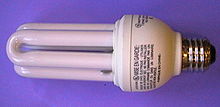
Back مصباح فلوري Arabic بولا فلورية ARY Lluminaria fluorescente AST Люмінесцэнтная лямпа Byelorussian Люмінэсцэнтная лямпа BE-X-OLD Луминесцентна лампа Bulgarian ফ্লুরোসেন্ট বাতি Bengali/Bangla Fluorescentna lampa BS Llum fluorescent Catalan Nĭk-guŏng-dĕng CDO





A fluorescent lamp, or fluorescent tube, is a low-pressure mercury-vapor gas-discharge lamp that uses fluorescence to produce visible light. An electric current in the gas excites mercury vapor, to produce ultraviolet and make a phosphor coating in the lamp glow. Fluorescent lamps convert electrical energy into useful light much more efficiently than incandescent lamps, but are less efficient than most LED lamps. The typical luminous efficacy of fluorescent lamps is 50–100 lumens per watt, several times the efficacy of incandescent bulbs with comparable light output (e.g. the luminous efficacy of an incandescent lamp may only be 16 lm/w).
Fluorescent lamp fixtures are more costly than incandescent lamps because, among other things, they require a ballast to regulate current through the lamp, but the initial cost is offset by a much lower running cost. Compact fluorescent lamps made in the same sizes as incandescent lamp bulbs are used as an energy-saving alternative to incandescent lamps in homes.
In the United States, fluorescent lamps are classified as universal waste. The United States Environmental Protection Agency recommends that fluorescent lamps be segregated from general waste for recycling or safe disposal, and some jurisdictions require recycling of them.[3]
- ^ "Mercury-containing Lights and Lamps as Universal Waste". Washington State Department of Ecology. Archived from the original on 2016-06-04. Retrieved 2016-06-11.
- ^ M. A. Laughton. Electrical Engineer's Reference Book Sixteenth Edition, Newnes, 2003 ISBN 0-7506-4637-3, pp. 21–12.
- ^ Mercury-Containing Light Bulb (Lamp) Recycling | Universal Waste | US EPA Archived 2015-06-29 at the Wayback Machine.

